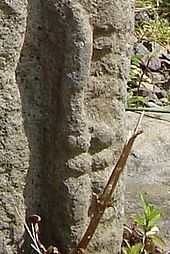Rodney's Stone
The Rodney's Stone (also Rodney Stone , also the name of a historical novel by Arthur Conan Doyle 1859-1930) is one of Oghamschrift -provided Pictish Stone of Class II (that is on the back of a cross-slab ), which in 1781 during the construction of Dyke Parish Church was found. Today it stands north of the A96 , about five kilometers west of Forres near Brodie Castle , in Moray in Scotland .
description
The front of the roughly 1.9 m high and 1.05 m wide rectangular plate from the 9th century made of gray sandstone bears a cross relief, filled with knot patterns and flanked in the corners by barely recognizable intertwined snakes.
The back shows two fish-tailed monsters above and below the Pictish Beast as well as a double disc and a Z-bar. The stone is remarkable because of its inscription in Ogham , which was found on the side surfaces and in remnants also next to the cross. It is the longest of all surviving Pictish-language - illegible - inscriptions. Much of it is weathered, but the rest apparently contains the name Ethernan "EDDARRNON", a name also borne by a prominent Pictish saint.
Surname
It is said that Rodney's Stone was named after Admiral Rodney , victor over Count de Grasse in the 1782 Battle of Les Saintes ("the Saint"). However, it is likely the name of the gravedigger Rotteny who found it.
Nearby
About 6.5 km away, just outside of Forres, there is a glass case, the Sueno stone , a flawless Pictish symbol stone.
literature
- S. Fraser: Rodney's Stone; Laser Scan, Moray (Dyke and Moy parish), 3-D laser scan , In: Discovery Excav Scot, New, Vol. 11 Cathedral Communications Limited, Wiltshire, 2010 England.
Web links
- Description of the stone on the Aberdeenshire Council website
- Entry on Rodney's Stone in Canmore, Historic Environment Scotland's database
- Rodney's Stone Pictish symbol stones in the database of the University of Strathclyde (English)
Coordinates: 57 ° 35 '49.4 " N , 3 ° 42' 3.5" W.



